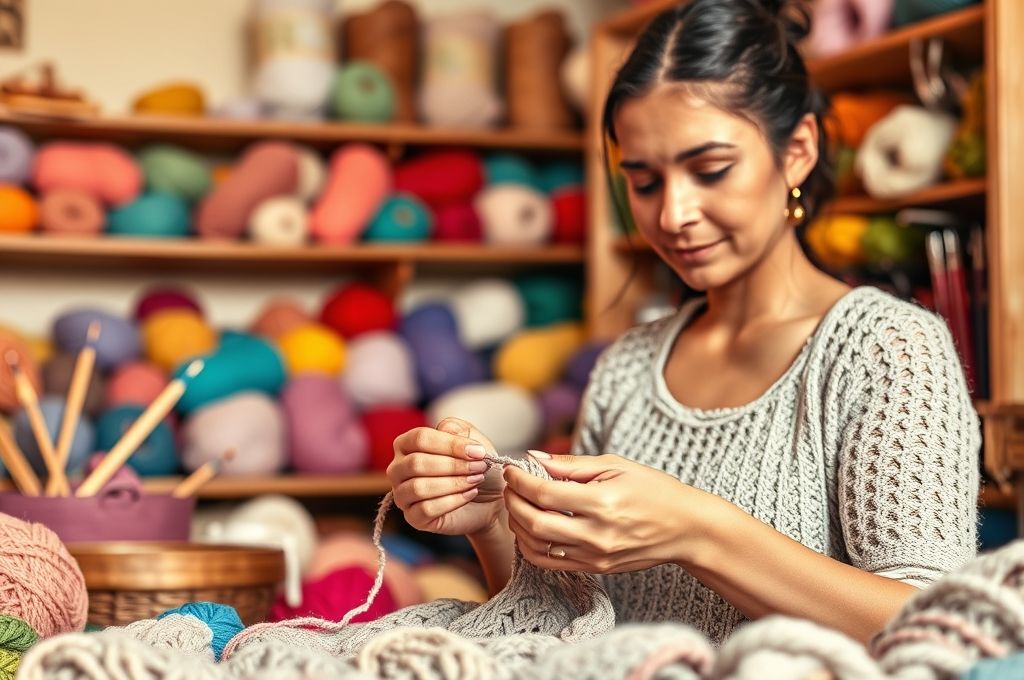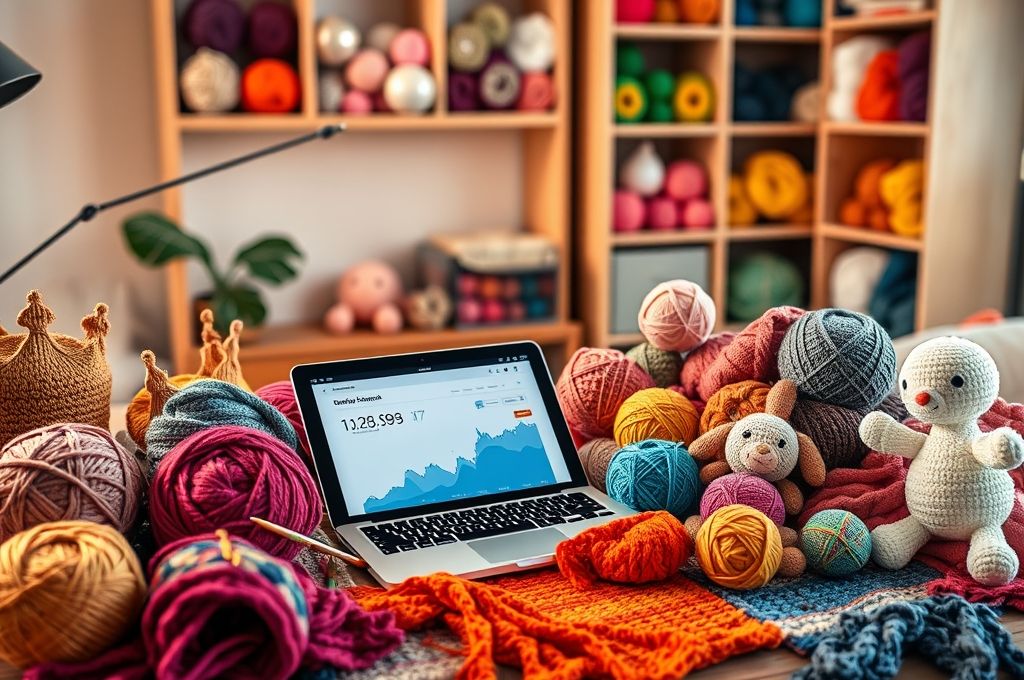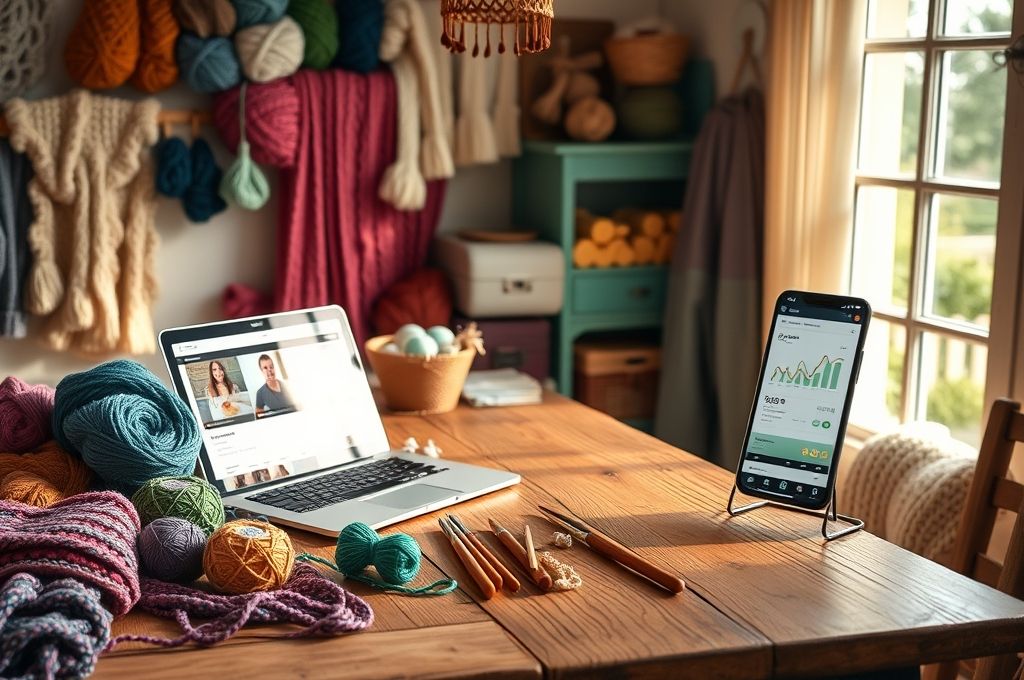From Passion to Profit
Imagine turning your crochet hooks into a paycheck. You’ve spent countless hours perfecting your stitches, designing beautiful patterns, and sharing your creations online. Now, what if your passion could not only bring joy to others but also generate real income? That’s exactly what thousands of crafters around the world are doing—monetizing their crochet blogs and YouTube channels.
Whether you’re a seasoned crocheter or just starting to share your journey online, the digital world offers endless opportunities to turn your hobby into a sustainable side hustle—or even a full-time business. From affiliate marketing to selling digital products, the path to earning from your craft is more accessible than ever.
In this article, we’ll explore practical, proven ways to monetize your crochet content. You’ll learn how to grow your audience, build trust, and convert your creativity into income—without losing the authenticity that makes your work special. We’ll cover everything from ad revenue and sponsorships to creating and selling your own patterns and courses.
By the end, you’ll have a clear roadmap to start earning from your blog or YouTube channel. So grab your favorite yarn, settle in, and let’s turn your love for crochet into a thriving online presence that pays.
1. Build a Loyal Audience: The Foundation of Monetization

Before you can earn from your content, you need an audience that trusts and values what you create. Think of your blog or YouTube channel like a cozy yarn shop—people come back because they love the vibe, the products, and most importantly, the person behind the counter.
Growing a loyal audience starts with consistency. Whether you post a new crochet tutorial every Tuesday or share behind-the-scenes stories every weekend, regular content keeps your audience engaged. But it’s not just about frequency—it’s about connection.
Ask yourself: What makes your crochet content unique? Maybe you specialize in beginner-friendly patterns, or perhaps you create whimsical amigurumi animals. Whatever your niche, lean into it. Use clear titles, engaging thumbnails, and relatable storytelling to draw people in.
For example, Sarah, a crochet YouTuber from Oregon, started her channel teaching simple dishcloth patterns. Over time, she noticed her viewers loved quick, practical projects. She shifted her focus to “30-minute crochet makes” and saw her subscriber count double in six months.
Pro Tip: Engage with your audience! Reply to comments, ask for feedback, and even host live Q&A sessions. When people feel seen, they’re more likely to stick around—and support you financially.
Remember: Monetization doesn’t happen overnight. But every comment, like, and share is a step toward building a community that believes in your work.
2. Monetize with Ads: Earnings from Views and Traffic
Once you’ve built a steady audience, one of the first monetization options you’ll likely explore is advertising. On YouTube, this means joining the YouTube Partner Program (YPP), which allows you to earn money from ads shown on your videos. For bloggers, platforms like Google AdSense or Mediavine can display ads on your site and pay you based on clicks or impressions.
To qualify for YPP, you need:
- 1,000 subscribers
- 4,000 valid public watch hours in the past 12 months
For AdSense, the requirements are more flexible—you just need a compliant website with original content. However, to maximize earnings, focus on traffic quality and quantity.
Here’s how it works: when someone watches your video or visits your blog, ads appear. You earn a small amount each time someone views or clicks on an ad. While the payout per view is low (often just a few cents), high-volume content can generate serious income.
For instance, a popular “beginner crochet blanket tutorial” might get 50,000 views a month. At an average $2 per 1,000 views (RPM), that’s $100 monthly—just from ads.
Tips to Boost Ad Revenue:
- Optimize video titles and thumbnails for search (e.g., “Easy Crochet Baby Blanket – No Experience Needed”)
- Use SEO-friendly keywords in blog posts (like “free crochet patterns for beginners”)
- Keep viewers watching longer—add chapters, end screens, and playlists
While ad revenue alone may not make you rich, it’s a passive income stream that grows as your audience does. And the best part? It requires minimal effort once set up.
3. Embrace Affiliate Marketing: Earn by Recommending Products You Love
Have you ever recommended a yarn brand or a pair of ergonomic hooks to a friend? Now imagine getting paid every time someone buys through your recommendation. That’s affiliate marketing—and it’s one of the most effective ways to monetize your crochet content.
Affiliate programs are free to join and work like this: you share a special tracking link to a product (like a crochet kit on Amazon or a pattern on Etsy). When someone buys using your link, you earn a commission—usually 5% to 20%, depending on the platform.
Popular affiliate programs for crafters include:
- Amazon Associates (wide range of products)
- ShareASale (hosts brands like Lion Brand Yarn)
- Etsy Affiliate Program (earn on handmade goods)
- Craftsy/Bluprint (crafting classes and tools)
Let’s say you create a video titled “My Top 5 Crochet Tools for Beginners.” In the description, you include your affiliate links to each item. If 100 people buy the recommended crochet hook through your link at $10 each with a 10% commission, you earn $100—effortlessly.
Best Practices:
- Only promote products you’ve used and trust
- Be transparent: disclose affiliate links (required by law and builds trust)
- Use comparison posts like “Wool vs. Cotton Yarn: Which Is Better for Amigurumi?”
Affiliate marketing works best when it feels natural. Instead of hard-selling, focus on educating. Your audience will appreciate honest recommendations—and you’ll earn while helping them make better choices.
4. Sell Your Own Digital Products: Turn Skills into Scalable Income

Here’s a powerful truth: your knowledge is valuable. Every pattern you’ve designed, every tutorial you’ve filmed, can become a product that earns money while you sleep.
Unlike physical goods, digital products—like PDF patterns, e-books, or video courses—have no shipping, no inventory, and near-zero production cost after the initial creation. This makes them one of the most profitable ways to monetize your crochet expertise.
Let’s break down the options:
1. Crochet Patterns (PDFs):
Create and sell downloadable patterns for blankets, toys, or wearables. Platforms like Etsy, Ravelry, and Payhip make it easy to list and sell.
For example, a single amigurumi fox pattern priced at $5 can sell hundreds of copies. If you sell 300 units in a year, that’s $1,500 in revenue—with almost no ongoing effort.
2. Online Courses:
Teach beginners how to crochet or guide advanced crafters through complex techniques. Use platforms like Teachable, Udemy, or Skillshare.
A course like “Master the Granny Square in 7 Days” could be priced at $29. Even with just 50 students, that’s $1,450.
3. E-books & Guides:
Compile your best tips into a resource like “The Ultimate Crochet Stitch Dictionary” or “How to Fix Common Crochet Mistakes.”
Tips for Success:
- Use Canva or Adobe Illustrator to design professional-looking PDFs
- Include clear photos and step-by-step instructions
- Offer a free mini-pattern to grow your email list
Selling digital products not only boosts income but also positions you as an expert. Plus, your audience gets real value—win-win!
5. Offer Services and Custom Work: Personalized Income Streams
While digital products scale well, personalized services allow you to charge premium rates and build deeper relationships with clients.
Consider these service-based ideas:
1. Custom Crochet Commissions:
People love one-of-a-kind handmade items. Offer to create custom blankets, baby clothes, or pet sweaters. Price based on time, materials, and complexity.
For example, a personalized baby blanket with the child’s name might sell for $80–$120. With just two orders a month, that’s nearly $2,400 a year.
2. Pattern Testing & Design Assistance:
Experienced crocheters can offer their skills to other designers. Many indie pattern creators pay testers $20–$50 per pattern to crochet and review their designs.
3. Virtual Crochet Coaching:
Host one-on-one sessions to help beginners overcome frustration or guide advanced crafters in designing their own patterns.
Platforms like Zoom and Calendly make scheduling easy. Charge $30–$50 per hour, and market your services through your blog or YouTube community.
Why Services Work:
- Higher perceived value than digital products
- Builds personal connection and word-of-mouth referrals
- Flexible—you can scale up or down based on your time
Just be mindful of time management. Set clear boundaries, use contracts, and avoid undercharging. Your time and skill are worth it.
6. Leverage Sponsorships and Brand Partnerships
As your audience grows, brands may start reaching out to collaborate. Sponsorships are a lucrative way to monetize your influence—where a company pays you to feature their product in your content.
For example, a yarn company might pay you $500 to create a video using their new eco-friendly cotton line. In return, you showcase their product, mention them in the video, and link to their site.
But you don’t have to wait for brands to find you. Proactively reach out to companies that align with your values. Look for:
- Yarn manufacturers (e.g., Bernat, Red Heart)
- Craft tool brands (e.g., Clover, Knitter’s Pride)
- Subscription boxes (e.g., We Craft Box, I Love Yarn Club)
How to Land Sponsorships:
- Build a media kit with your stats (audience size, demographics, engagement)
- Show past successful collaborations (even small ones)
- Pitch creative ideas—like a “Month of Crochet with [Brand] Yarn”
Transparency is key. Always disclose sponsorships (“This video is sponsored by…”) to maintain trust.
Even small channels can attract sponsors. A YouTuber with 5,000 subscribers once earned $300 for a single 60-second product mention—because her audience was highly engaged and niche-specific.
Sponsorships not only bring income but also introduce your audience to quality products, enhancing your value as a trusted creator.
7. Grow with Email Marketing: Build a Direct Line to Your Audience
You’ve seen it before: a sudden algorithm change causes your YouTube views or blog traffic to drop. It’s frustrating—and it highlights a crucial truth: you don’t own your social media audience.
But your email list? That’s yours. No algorithms, no throttling. Just a direct line to people who’ve chosen to hear from you.
Start building your email list today. Offer a freebie—like a “Beginner’s Crochet Stitch Guide” or a “Free Coaster Pattern Pack”—in exchange for an email address. Use tools like MailerLite, ConvertKit, or Bloom (for WordPress) to manage sign-ups.
Once you have subscribers, send regular, valuable emails:
- Weekly tips and tricks
- Exclusive pattern discounts
- Behind-the-scenes updates
- New product launches
Email marketing converts better than any other channel. For example, when you launch a new crochet course, your email list is the first to know—and they’re far more likely to buy than a cold audience.
Pro Tip: Segment your list. Separate beginners from advanced crocheters so you can send targeted content. This increases engagement and sales.
Over time, your email list becomes your most valuable asset—one that grows stronger with every message you send.
8. Diversify Your Income: Don’t Put All Your Yarn in One Basket
Here’s the secret most successful creators won’t tell you: diversification is the key to sustainable income.
Relying on just one monetization method—like ad revenue—is risky. Algorithms change, platforms evolve, and trends fade. But when you have multiple income streams, you’re protected.
Imagine this:
- $200/month from YouTube ads
- $150/month from affiliate sales
- $300/month from pattern sales
- $100/month from sponsorships
- $50/month from coaching
That’s $800/month—not bad for a side hustle. And if one stream slows down, the others keep you afloat.
Think of your income like a crochet blanket: each stitch (income stream) is small on its own, but together, they create something strong and warm.
Ways to Diversify:
- Combine digital products with services
- Run seasonal sales (e.g., “Holiday Crochet Bundle”)
- Launch a Patreon or membership site for exclusive content
- Sell physical kits (yarn + pattern + hook)
The goal isn’t to do everything at once—but to gradually add new streams as your audience grows.
9. Stay Authentic: The Heart of Long-Term Success
In a world of filters and fast trends, authenticity is your superpower.
People don’t follow you just for perfect stitches—they follow because they like you. They relate to your struggles, celebrate your wins, and trust your recommendations.
So don’t try to be someone you’re not. Share your messy first attempts. Talk about the project that didn’t turn out as planned. Let your personality shine through.
When you stay true to yourself, your audience stays loyal. And loyal audiences are the ones who buy your patterns, click your links, and support your journey.
Remember: monetization isn’t about squeezing every dollar from your audience. It’s about creating value—and being fairly compensated for it.
As crochet artist and blogger Mia Torres says, “I didn’t start crocheting to make money. I started because it made me happy. But when I shared that joy honestly, the income followed.”
Let your passion lead. The profits will come.
Conclusion: Your Hooks, Your Hustle
Monetizing your crochet blog or YouTube channel isn’t about becoming the next viral sensation. It’s about recognizing the value of your time, talent, and creativity—and building a sustainable way to share it with the world.
We’ve covered a lot: from growing your audience and earning with ads, to selling digital products, offering services, and building an email list. Each step is a stitch in the bigger picture of your creative business.
Start small. Pick one method—maybe affiliate marketing or a simple PDF pattern—and test it. Learn from the results. Then add another stream. Over time, you’ll create a tapestry of income that supports your passion.
And remember: every expert was once a beginner. Every successful creator started with a single post, a single video, a single idea.
So keep crocheting. Keep creating. And don’t be afraid to ask, “What if this could also be my income?”
Now it’s your turn: What’s the first monetization step you’ll take this week? Share it in the comments below—or better yet, start drafting that first pattern today. Your journey from passion to profit begins now.

Daniele Ferreira is passionate about the world of crochet, dedicating her time to exploring techniques, creating unique pieces, and sharing her knowledge with beginners and aficionados alike. With attention to detail and creativity, she transforms yarn into true works of art, inspiring others to discover the beauty and joy of this manual art.







